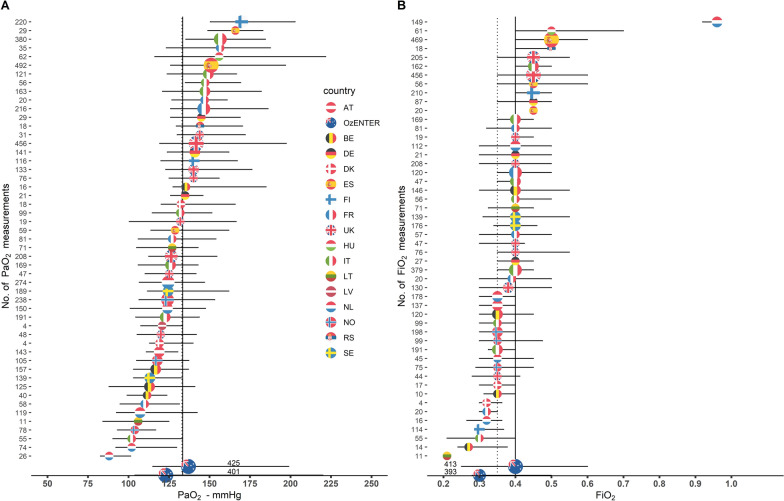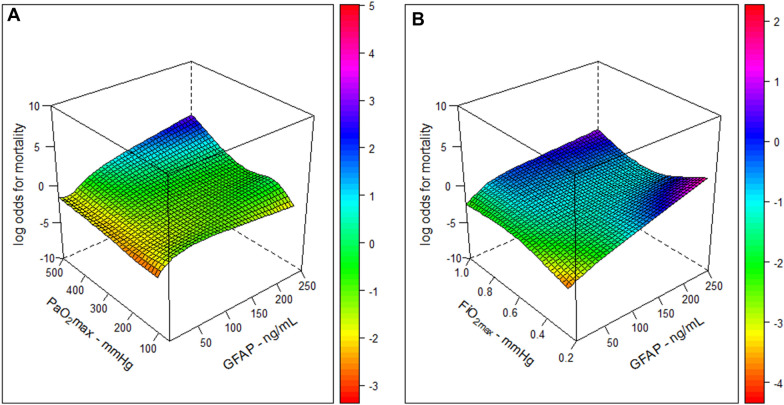Correction: Intensive Care Medicine 10.1007/s00134-022-06884-x
Figure 1 contained some incorrect colors of the representative country flags that are now corrected. Figure 3 was updated: we represented the interaction between PaO2max and FiO2max with mortality in both panels. Consequently, the Figure 3 caption was edited as follows: “Fig. 3. Tensor cubic spline for the interaction between PaO2max and FiO2max with GFAP. In panel A on the left, we represented the tensor cubic spline with 4 degrees of freedom each, used for the interaction between PaO2max and GFAP in the multivariable logistic model with 6-month mortality as the outcome (i.e. model 2 of Table 2). In panel B on the right, we represented the tensor cubic spline with 4 degrees of freedom each, used for the interaction between FiO2max and GFAP in the multivariable logistic model with 6-month mortality as the outcome (i.e. model 4 of Table 2). All other continuous covariates (i.e. Supplemental Table 6 and 10) were set to median values and mid-category for categorical ones.”
Table 2.
Multivariable models on GOSE and mortality at 6-month follow-up in CENTER-TBI (Models 1, 2, 3 and 4)
| CENTER-TBI | 6-month GOSE N = 912 patients, 489 GOSE≤4 |
6-month mortality N = 912 patients, 225 died |
||||
|---|---|---|---|---|---|---|
| Model 1 | OR* | 95% CI | p | OR* | 95% CI | p value |
| PaO2max (for 10 mmHg increase) | 1.02 | 1–1.04 | 0.014 | 1.03 | 1.01–1.05 | 0.002 |
| PaO2mean (for 10 mmHg increase) | 1.03 | 1–1.07 | 0.059 | 1.08 | 1.04–1.13 | < 0.001 |
| ΔPaO2mean (for 10 mmHg increase)b | 1.07 | 1.03–1.12 | 0.001 | 1.14 | 1.08–1.20 | < 0.001 |
| 6-month GOSE N = 764 patients, 407 GOSE≤4 |
6-month mortality N = 764 patients, 175 died |
|||||
|---|---|---|---|---|---|---|
| Model 2 | OR* | 95% CI | p | OR* | 95% CI | p |
| Logarithm GFAP | 1.51 | 1.33–1.71 | < 0.001 | 1.51 | 1.29–1.77 | < 0.001 |
| PaO2max (for 10 mmHg increase) | 1.02 | 1–1.03 | 0.064 | 1.03 | 1.01–1.05 | 0.008 |
| Logarithm GFAP | 1.52 | 1.34–1.72 | < 0.001 | 1.52 | 1.3–1.78 | < 0.001 |
| PaO2mean (for 10 mmHg increase) | 1.03 | 0.99–1.07 | 0.092 | 1.09 | 1.04–1.14 | 0.001 |
| Logarithm GFAP | 1.52 | 1.34–1.72 | < 0.001 | 1.53 | 1.3–1.81 | < 0.001 |
| ΔPaO2mean (for 10 mmHg increase) | 1.05 | 1–1.11 | 0.031 | 1.14 | 1.08–1.21 | < 0.001 |
| 6-month GOSE N = 877 patients, 470 GOSE≤4 |
6-month mortality N = 877 patients, 212 died |
|||||
|---|---|---|---|---|---|---|
| Model 3 | OR*** | 95% CI | p | OR*** | 95% CI | p |
| FiO2max (for 0.1 increase) | 1.03 | 0.96–1.1 | 0.453 | 1.18 | 1.08–1.29 | < 0.001 |
| FiO2mean, (for 0.1 increase) | 1.02 | 0.92–1.14 | 0.694 | 1.31 | 1.13–1.51 | < 0.001 |
| ΔFiO2mean, (for 0.1 increase) | 1.03 | 0.84–1.27 | 0.761 | 1.46 | 1.13–1.88 | 0.004 |
| 6-month GOSE N = 741 patients, 397 GOSE≤4 |
6-month mortality N = 741 patients, 168 died |
|||||
|---|---|---|---|---|---|---|
| Model 4 | OR* | 95% CI | p | OR* | 95% CI | p |
| Logarithm GFAP | 1.52 | 1.34–1.72 | < 0.001 | 1.55 | 1.31–1.83 | < 0.001 |
| FiO2max (for 0.1 increase) | 1.03 | 0.96–1.12 | 0.389 | 1.20 | 1.08–1.33 | 0.001 |
| Logarithm GFAP | 1.52 | 1.34–1.72 | < 0.001 | 1.55 | 1.32–1.84 | < 0.001 |
| FiO2mean (for 0.1 increase) | 1.04 | 0.93–1.17 | 0.498 | 1.33 | 1.13–1.55 | < 0.001 |
| Logarithm GFAP | 1.51 | 1.33–1.72 | < 0.001 | 1.55 | 1.31–1.83 | < 0.001 |
| ΔFiO2mean (for 0.1 increase) | 0.98 | 0.78–1.23 | 0.846 | 1.40 | 1.05–1.87 | 0.023 |
* OR is for 10 mmHg increase in PaO2 covariate ** 1 patient did not have low PaO2 ***OR regards 0.1 increments in FiO2 covariate
Table 2 was updated: model 4 - about the adjustment of FiO2 levels with the degree of brain injury severity (i.e. log GFAP) - was reported. Consequently, Supplemental Tables 9 and 10 were added to provide full models with all confounders of model 4 – Table 2.
In the abstract (i.e. results section), the following sentence “GFAP was independently associated with mortality and functional neurologic outcome at follow-up, but it did not modulate the outcome impact of high PaO2 levels, which remained independently associated with 6-month mortality.” was replaced with the following one: “GFAP was independently associated with mortality and functional neurologic outcome at follow-up, but it did not modulate the outcome impact of high PaO2 and FiO2 levels, which remained independently associated with 6-month mortality.”
In the introduction section, the third bullet point was revised as “3. evaluate whether the impact of high levels of oxygen exposure or high levels of supplemental oxygen on 6-month outcome could be worsened by increasing brain injury severity, as assessed by acute (first 24 h) serum levels of GFAP in the CENTER-TBI cohort.”
The labels of Figure 1, 2 and 3 were updated by adding the reference of the study cohort as follows: “Fig. 1 Center-specific median values of daily highest PaO2 and FiO2 in CENTER-TBI and OzENTER-TBI cohorts.” “Fig. 2 The model-based probability for mortality in CENTER-TBI.” “Fig. 3 Tensor cubic spline for the interaction between PaO2max and FiO2max with GFAP in CENTER-TBI.” In the legend of Figure 2 we replaced “Model 2” with “Model 1”.
In the results section (i.e. Center-TBI - Arterial oxygen levels and outcomes in TBI patients) the following sentence “We did not find any interaction between the studied variables, as shown in Fig. 3 (panels A and B), where the surfaces that represent the smoothed interactions (on a log scale) are mainly flattened on zero.” was replaced with the following one “We did not find any interaction between the studied variables, as shown in Supplemental Figure 4 (panel A) and Figure 3 (panel A), respectively, for PaO2max - and both PaO2mean and ΔPaO2mean as well (data not shown) - where the surfaces that represent the smoothed interactions (on a log scale) are mainly flattened on zero.”
The caption of Table 2 was changed according to the updated Table 2, and the following sentence was added: “Model 4. Model 3 plus the degree of brain injury quantified as GFAP levels.” The title of Table 2 has been updated as follows: “Table 2 Multivariable models on GOSE and mortality at 6-month follow-up in CENTER-TBI (Models 1, 2, 3 and 4)”.
In the results section (i.e. Center-TBI - Supplemental oxygen administration and outcome), the following sentence was added according to the inclusion of model 4 in the updated Table 2: “We also explored the role of exposure to high supplemental oxygen levels on the neurologic outcome by further adjusting the model for GFAP levels. GFAP was positively associated with a lower GOSE score and a higher mortality rate. No association was observed with GOSE among the variables representing higher supplemental oxygen. However, all three high supplemental oxygen variables remained positively associated with a higher mortality rate (Model 4, Table 2). A detailed description of all confounders estimates is reported in Supplemental Tables 9 and 10.”
Additionally, in the results section (i.e. Center-TBI - Supplemental oxygen administration and outcome), the following sentence was added: “We explored the presence of interaction on GOSE and mortality between exposure to high FiO2 levels and GFAP levels. We did not find any interaction among the studied variables, as shown in Supplemental Figure 4 (panel B) and in Figure 3 (panel B), respectively, for FiO2max - and for both FiO2mean and ΔFiO2mean as well (data not shown) - where the surfaces that represent the smoothed interactions (on a log scale) are mainly flattened on zero.” according to the updated Figure 3 that explored the presence of interaction between the study parameters (i.e. PaO2max and FiO2max) with mortality. The interaction between PaO2max and FiO2max with GOSE was evaluated in Supplemental Figure 4.
Supplemental Tables 9, 10, 11, 12, 13, 14, and 15 were renumbered as Supplemental Tables 11, 12, 13, 14, 15, 16, and 17.
The original article has been updated. The Authors apologize for the mistakes.
Fig. 1
Fig. 3
Supplementary Information
Below is the link to the electronic supplementary material.
Footnotes
Publisher's Note
Springer Nature remains neutral with regard to jurisdictional claims in published maps and institutional affiliations.
Contributor Information
Giuseppe Citerio, Email: giuseppe.citerio@unimib.it.
CENTER-TBI, OzENTER-TBI Participants and Investigators:
Cecilia Ackerlund, Krisztina Amrein, Nada Andelic, Lasse Andreassen, Audny Anke, Gérard Audibert, Philippe Azouvi, Maria Luisa Azzolini, Ronald Bartels, Ronny Beer, Bo-Michael Bellander, Habib Benali, Maurizio Berardino, Luigi Beretta, Erta Beqiri, Morten Blaabjerg, Stine Borgen Lund, Camilla Brorsson, Andras Buki, Manuel Cabeleira, Alessio Caccioppola, Emiliana Calappi, Maria Rosa Calvi, Peter Cameron, Guillermo Carbayo Lozano, Marco Carbonara, Ana M. Castaño-León, Simona Cavallo, Giorgio Chevallard, Arturo Chieregato, Giuseppe Citerio, Hans Clusmann, Mark Steven Coburn, Jonathan Coles, Jamie D. Cooper, Marta Correia, Endre Czeiter, Marek Czosnyka, Claire Dahyot-Fizelier, Paul Dark, Véronique Keyser, Vincent Degos, Francesco Della Corte, Hugo Boogert, Bart Depreitere, Đula Đilvesi, Abhishek Dixit, Jens Dreier, Guy-Loup Dulière, Ari Ercole, Erzsébet Ezer, Martin Fabricius, Kelly Foks, Shirin Frisvold, Alex Furmanov, Damien Galanaud, Dashiell Gantner, Alexandre Ghuysen, Lelde Giga, Jagoš Golubović, Pedro A. Gomez, Benjamin Gravesteijn, Francesca Grossi, Deepak Gupta, Iain Haitsma, Raimund Helbok, Eirik Helseth, Jilske Huijben, Peter J. Hutchinson, Stefan Jankowski, Faye Johnson, Mladen Karan, Angelos G. Kolias, Daniel Kondziella, Evgenios Kornaropoulos, Lars-Owe Koskinen, Noémi Kovács, Ana Kowark, Alfonso Lagares, Steven Laureys, Aurelie Lejeune, Fiona Lecky, Didier Ledoux, Roger Lightfoot, Hester Lingsma, Andrew I. R. Maas, Alex Manara, Hugues Maréchal, Costanza Martino, Julia Mattern, Catherine McMahon, David Menon, Tomas Menovsky, Benoit Misset, Visakh Muraleedharan, Lynnette Murray, Ancuta Negru, David Nelson, Virginia Newcombe, József Nyirádi, Fabrizio Ortolano, Jean-François Payen, Vincent Perlbarg, Paolo Persona, Wilco Peul, Anna Piippo-Karjalainen, Horia Ples, Inigo Pomposo, Jussi P. Posti, Louis Puybasset, Andreea Rădoi, Arminas Ragauskas, Rahul Raj, Jonathan Rhodes, Sophie Richter, Saulius Rocka, Cecilie Roe, Olav Roise, Jeffrey Rosenfeld, Christina Rosenlund, Guy Rosenthal, Rolf Rossaint, Sandra Rossi, Juan Sahuquillo, Oliver Sakowitz, Renan Sanchez-Porras, Oddrun Sandrød, Kari Schirmer-Mikalsen, Rico Frederik Schou, Charlie Sewalt, Peter Smielewski, Abayomi Sorinola, Emmanuel Stamatakis, Ewout W. Steyerberg, Nino Stocchetti, Nina Sundström, Riikka Takala, Viktória Tamás, Tomas Tamosuitis, Olli Tenovuo, Matt Thomas, Dick Tibboel, Christos Tolias, Tony Trapani, Cristina Maria Tudora, Andreas Unterberg, Peter Vajkoczy, Egils Valeinis, Shirley Vallance, Zoltán Vámos, Gregory Steen, T. J. M. van Dijck Jeroen, Thomas A. Essen, Roel Wijk, Alessia Vargiolu, Emmanuel Vega, Anne Vik, Rimantas Vilcinis, Victor Volovici, Peter Vulekovic, Eveline Wiegers, Guy Williams, Stefan Winzeck, Stefan Wolf, Alexander Younsi, Frederick A. Zeiler, Agate Ziverte, Tommaso Zoerle, Jamie Cooper, Dashiell Gantner, Russel Gruen, Lynette Murray, Jeffrey V. Rosenfeld, Dinesh Varma, Tony Trapani, Shirley Vallance, Christopher MacIsaac, and Andrea Jordan
Associated Data
This section collects any data citations, data availability statements, or supplementary materials included in this article.




